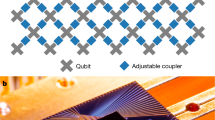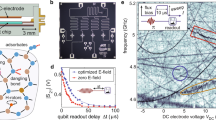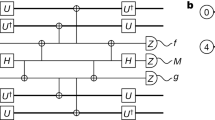Abstract
Quantum mechanics can help to solve complex problems in physics1 and chemistry2, provided they can be programmed in a physical device. In adiabatic quantum computing3,4,5, a system is slowly evolved from the ground state of a simple initial Hamiltonian to a final Hamiltonian that encodes a computational problem. The appeal of this approach lies in the combination of simplicity and generality; in principle, any problem can be encoded. In practice, applications are restricted by limited connectivity, available interactions and noise. A complementary approach is digital quantum computing6, which enables the construction of arbitrary interactions and is compatible with error correction7,8, but uses quantum circuit algorithms that are problem-specific. Here we combine the advantages of both approaches by implementing digitized adiabatic quantum computing in a superconducting system. We tomographically probe the system during the digitized evolution and explore the scaling of errors with system size. We then let the full system find the solution to random instances of the one-dimensional Ising problem as well as problem Hamiltonians that involve more complex interactions. This digital quantum simulation9,10,11,12 of the adiabatic algorithm consists of up to nine qubits and up to 1,000 quantum logic gates. The demonstration of digitized adiabatic quantum computing in the solid state opens a path to synthesizing long-range correlations and solving complex computational problems. When combined with fault-tolerance, our approach becomes a general-purpose algorithm that is scalable.
This is a preview of subscription content, access via your institution
Access options
Subscribe to this journal
Receive 51 print issues and online access
$199.00 per year
only $3.90 per issue
Buy this article
- Purchase on Springer Link
- Instant access to full article PDF
Prices may be subject to local taxes which are calculated during checkout




Similar content being viewed by others
References
Feynman, R. P. Simulating physics with computers. Int. J. Theor. Phys. 21, 467–488 (1982)
Aspuru-Guzik, A., Dutoi, A. D., Love, P. J. & Head-Gordon, M. Simulated quantum computation of molecular energies. Science 309, 1704–1707 (2005)
Farhi, E., Goldstone, J., Gutmann, S. & Sipser, M. Quantum computation by adiabatic evolution. Preprint at http://arxiv.org/abs/quant-ph/0001106 (2000)
Farhi, E. et al. A quantum adiabatic evolution algorithm applied to random instances of an NP-complete problem. Science 292, 472–475 (2001)
Nishimori, H. Statistical Physics of Spin Glasses and Information Processing: An Introduction (Oxford Univ. Press, 2001)
Lloyd, S. Universal quantum simulators. Science 273, 1073–1078 (1996)
Bravyi, S. B. & Kitaev, A. Yu. Quantum codes on a lattice with boundary. Preprint at http://arxiv.org/abs/quant-ph/9811052 (1998)
Fowler, A. G., Mariantoni, M., Martinis, J. M. & Cleland, A. N. Surface codes: towards practical large-scale quantum computation. Phys. Rev. A 86, 032324 (2012)
Steffen, M. et al. Experimental implementation of an adiabatic quantum optimization algorithm. Phys. Rev. Lett. 90, 067903 (2003)
Lanyon, B. P. et al. Universal digital quantum simulation with trapped ions. Science 334, 57–61 (2011)
Barends, R. et al. Digital quantum simulation of fermionic models with a superconducting circuit. Nat. Commun. 6, 7654 (2015)
Salathé, Y. et al. Digital quantum simulation of spin models with circuit quantum electrodynamics. Phys. Rev. X 5, 021027 (2015)
Bravyi, S., DiVincenzo, D. P., Oliveira, R. I. & Terhal, B. M. The complexity of stoquastic local Hamiltonian problems. Quantum Inf. Comput. 8, 361–385 (2008)
Aharonov, D. et al. Adiabatic quantum computation is equivalent to standard quantum computation. SIAM Rev. 50, 755–787 (2008)
Lloyd, S. & Terhal, B. M. Adiabatic and Hamiltonian computing on a 2D lattice with simple two-qubit interactions. New J. Phys. 18, 023042 (2016)
Crosson, E., Farhi, E., Lin, C. Y.-Y., Lin, H.-H. & Shor, P. Different strategies for optimization using the quantum adiabatic algorithm. Preprint at http://arxiv.org/abs/1401.7320 (2014)
Babbush, R., Love, P. J. & Aspuru-Guzik, A. Adiabatic quantum simulation of quantum chemistry. Sci. Rep. 4, 6603 (2014)
Troyer, M. & Wiese, U.-J. Computational complexity and fundamental limitations to fermionic quantum Monte Carlo simulations. Phys. Rev. Lett. 94, 170201 (2005)
Boixo, S. et al. Computational multiqubit tunnelling in programmable quantum annealers. Nat. Commun. 7, 10327 (2016)
Bravyi, S. B. & Kitaev, A. Yu. Fermionic quantum computation. Ann. Phys. 298, 210–226 (2002)
Seeley, J. T., Richard, M. J. & Love, P. J. The Bravyi–Kitaev transformation for quantum computation of electronic structure. J. Chem. Phys. 137, 224109 (2012)
Barends, R. et al. Coherent Josephson qubit suitable for scalable quantum integrated circuits. Phys. Rev. Lett. 111, 080502 (2013)
Kelly, J. et al. State preservation by repetitive error detection in a superconducting quantum circuit. Nature 519, 66–69 (2015)
Suzuki, M. Fractal decomposition of exponential operators with applications to many-body theories and Monte Carlo simulations. Phys. Lett. A 146, 319–323 (1990)
Barends, R. et al. Superconducting quantum circuits at the surface code threshold for fault tolerance. Nature 508, 500–503 (2014)
Kibble, T. W. B. Some implications of a cosmological phase transition. Phys. Rep. 67, 183–199 (1980)
Zurek, W. H. Cosmological experiments in superfluid helium? Nature 317, 505–508 (1985)
Wiebe, N., Berry, D., Hoyer, P. & Sanders, B. C. Higher order decompositions of ordered operator exponentials. J. Phys. A 43, 065203 (2010)
Berry, D., Childs, A. M., Cleve, R., Kothari, R. & Somma, R. D. Simulating Hamiltonian dynamics with a truncated Taylor series. Phys. Rev. Lett. 114, 090502 (2015)
Acknowledgements
We acknowledge support from Spanish MINECO FIS2012-36673-C03-02; Ramón y Cajal grant RYC-2012-11391; UPV/EHU UFI 11/55 and EHUA14/04; Basque Government IT472-10; a UPV/EHU PhD grant; and PROMISCE and SCALEQIT EU projects. Devices were made at the UC Santa Barbara Nanofabrication Facility, a part of the NSF-funded National Nanotechnology Infrastructure Network, and at the NanoStructures Cleanroom Facility.
Author information
Authors and Affiliations
Contributions
R. Barends, A.S. and L.L. designed the experiment, with E.S., H.N. and J.M.M. providing supervision and A. Mezzacapo, U.L.H. and R. Babbush providing additional theoretical support. R. Barends, A.S., L.L. and R. Babbush co-wrote the manuscript with E.S., H.N. and J.M.M. R. Barends, A.S. and L.L. performed the experiment and analysed the data. The device was designed by R. Barends and J.K. All authors contributed to the fabrication process, experimental set-up and manuscript preparation.
Corresponding authors
Ethics declarations
Competing interests
The authors declare no competing financial interests.
Supplementary information
Supplementary Information
This fie contains Supplementary Text and Data, Supplementary Figures 1-10, Supplementary Tables 1-10 and additional references. (PDF 2956 kb)
Rights and permissions
About this article
Cite this article
Barends, R., Shabani, A., Lamata, L. et al. Digitized adiabatic quantum computing with a superconducting circuit. Nature 534, 222–226 (2016). https://doi.org/10.1038/nature17658
Received:
Accepted:
Published:
Issue Date:
DOI: https://doi.org/10.1038/nature17658
This article is cited by
-
Improved machine learning algorithm for predicting ground state properties
Nature Communications (2024)
-
A quantum-inspired probabilistic prime factorization based on virtually connected Boltzmann machine and probabilistic annealing
Scientific Reports (2023)
-
Recent progress on coherent computation based on quantum squeezing
AAPPS Bulletin (2023)
-
Constant-depth circuits for dynamic simulations of materials on quantum computers
Materials Theory (2022)
-
Path toward manufacturable superconducting qubits with relaxation times exceeding 0.1 ms
npj Quantum Information (2022)
Comments
By submitting a comment you agree to abide by our Terms and Community Guidelines. If you find something abusive or that does not comply with our terms or guidelines please flag it as inappropriate.



